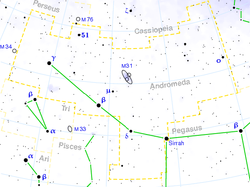- Delta Andromedae
-
δ Andromedae Observation data
Epoch J2000.0 Equinox J2000.0 (ICRS)Constellation Andromeda Right ascension 00h 39m 19.6758s[1] Declination +30° 51′ 39.686″[1] Apparent magnitude (V) 3.28[1] Characteristics Spectral type K3III / ?[2] U−B color index +1.48[3] B−V color index +1.28[3] R−I color index +0.66[3] Astrometry Radial velocity (Rv) −7.3 ± 0.9[1] km/s Proper motion (μ) RA: 115.38[1] mas/yr
Dec.: −83.05[1] mas/yrParallax (π) 32.19 ± 0.68[1] mas Distance 101 ± 2 ly
(31.1 ± 0.7 pc)Absolute magnitude (MV) 0.8[4] Details Mass ~1.8[2]/— M☉ Radius 11.50[5]/— R☉ Surface gravity (log g) 2.0 ± 0.3[2]/— Rotational velocity (v sin i) < 17[3]/— km/s Orbit[6] Period (P) 15,000 d Eccentricity (e) 0.34 ± 0.14 Periastron epoch (T) 2415568 JD Argument of periastron (ω)
(primary)356.1 ± 5.2° Semi-amplitude (K1)
(primary)4.0 ± 2.7 km/s Other designations Database references SIMBAD data Delta Andromedae (δ And, δ Andromedae) is a binary star system in the constellation Andromeda. It is approximately 101 light years from the Earth. Apart from its Bayer designation, it was also given the title Delta by Elijah H. Burritt in his star atlas.[8]
In Chinese, 奎宿 (Kuí Sù), meaning Legs (asterism), refers to an asterism consisting of δ Andromedae, η Andromedae, ζ Andromedae, ι Piscium, ε Andromedae, π Andromedae, ν Andromedae, μ Andromedae, σ Piscium, β Andromedae, τ Piscium, 91 Piscium, υ Piscium, φ Piscium, χ Piscium and spectroscopic binary with an orbital period of approximately 15,000 days (41 years) and an overall apparent visual magnitude of approximately 3.28. The primary of the spectroscopic binary is a K-type giant.[1][6] The secondary is believed to be relatively faint, as it has not yet been observed interferometrically. It may be either a main-sequence star of spectral type G or later, or a white dwarf. An excess of infrared radiation from δ Andromedae suggests that it is surrounded by a shell of dust.[2]
References
- ^ a b c d e f g h i NSV 15142 -- Spectroscopic binary, database entry, SIMBAD. Accessed on line August 28, 2008.
- ^ a b c d Delta Andromedae (K3 III) - an IRAS source with an unusual ultraviolet spectrum, P. G. Judge, C. Jordan, and M. Rowan-Robinson, Monthly Notices of the Royal Astronomical Society 224 (January 1, 1987), pp. 93–106, Bibcode: 1987MNRAS.224...93J.
- ^ a b c d HR 165, database entry, The Bright Star Catalogue, 5th Revised Ed. (Preliminary Version), D. Hoffleit and W. H. Warren, Jr., CDS ID V/50. Accessed on line August 28, 2008.
- ^ From apparent magnitude and parallax.
- ^ HD 3627, database entry, Catalog of Apparent Diameters and Absolute Radii of Stars (CADARS), 3rd edition, L. E. Pasinetti-Fracassini, L. Pastori, S. Covino, and A. Pozzi, CDS ID II/224. Accessed on line August 28, 2008.
- ^ a b The spectroscopic orbit of δ Andromedae, Gustav A. Bakos, Journal of the Royal Astronomical Society of Canada 70 (February 1976), pp. 23–26, Bibcode: 1976JRASC..70...23B.
- ^ Entry 00393+3052, The Washington Double Star Catalog, United States Naval Observatory. Accessed on line August 28, 2008.
- ^ Richard Hinckley Allen (1899) Star-names and Their Meanings, p. 38.
- ^ (Chinese) 中國星座神話, written by 陳久金. Published by 台灣書房出版有限公司, 2005, ISBN 978-986-7332-25-7.
- ^ (Chinese) AEEA (Activities of Exhibition and Education in Astronomy) 天文教育資訊網 2006 年 5 月 19 日
External links
- The Constellation Andromeda: The Chained Maiden, web page, European Southern Observatory outreach.
- Entry at heavens-above.com.
- Image Delta Andromedae
Bayer Flamsteed - 1 (ο)
- 2
- 3
- 4
- 5
- 6
- 7
- 8
- 9
- 10
- 11
- 12
- 13
- 14
- 15
- 16 (λ)
- 17 (ι)
- 18
- 19 (κ)
- 20 (ψ)
- 21 (α, Alpheratz)
- 22
- 23
- 24 (θ)
- 25 (σ)
- 26
- 27 (ρ)
- 28
- 29 (π)
- 30 (ε)
- 31 (δ)
- 32
- 34 (ζ)
- 35 (ν)
- 36
- 37 (μ)
- 38 (η)
- 39
- 41
- 42 (φ)
- 43 (β, Mirach)
- 44
- 45
- 46 (ξ, Adhil)
- 47
- 48 (ω)
- 49 (A)
- 50 (υ)
- 51
- 52 (χ)
- 53 (τ)
- 55
- 56
- 57 (γ, Almach)
- 58
- 59
- 60 (b)
- 62 (c)
- 63
- 64
- 65
- 66
- 6 Per
Nearby - HH (Ross 248)
- GX/GQ (Groombridge 34)
- GJ 1289
- List
Categories:- Andromeda constellation
- K-type giants
- Bayer objects
- Flamsteed objects
- Henry Draper Catalogue objects
- HIP objects
- Spectroscopic binaries
- Binary star systems
- Durchmusterung objects
Wikimedia Foundation. 2010.

